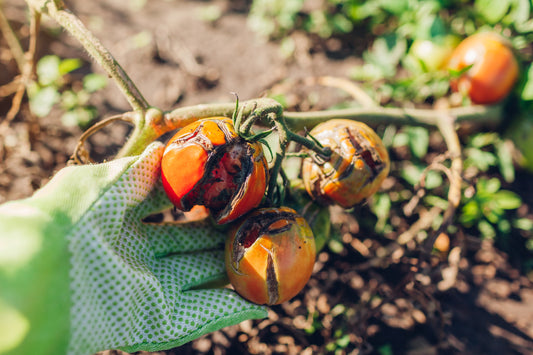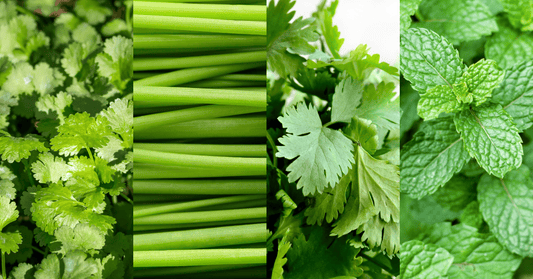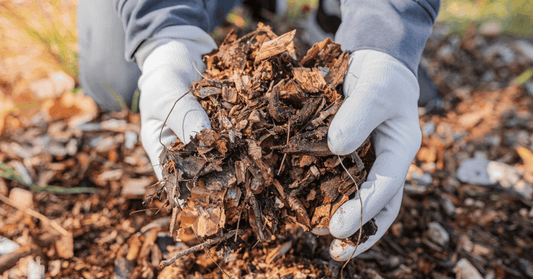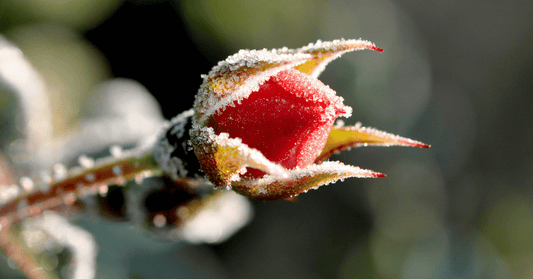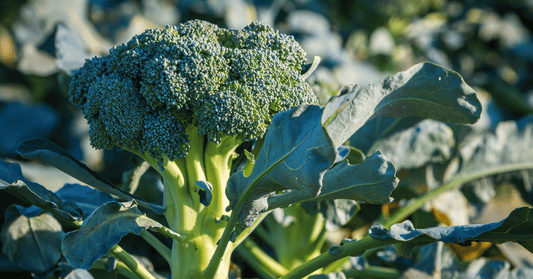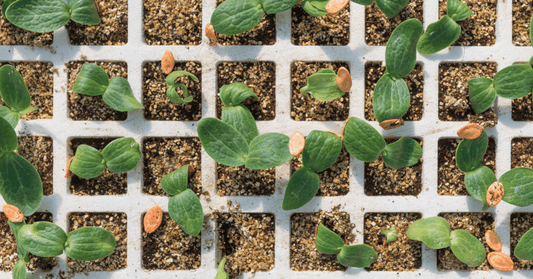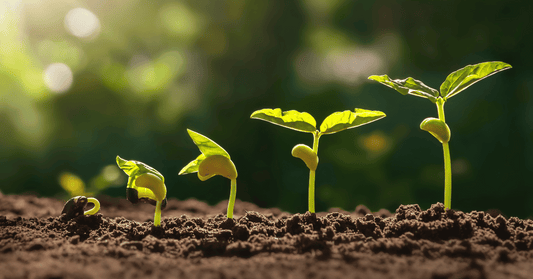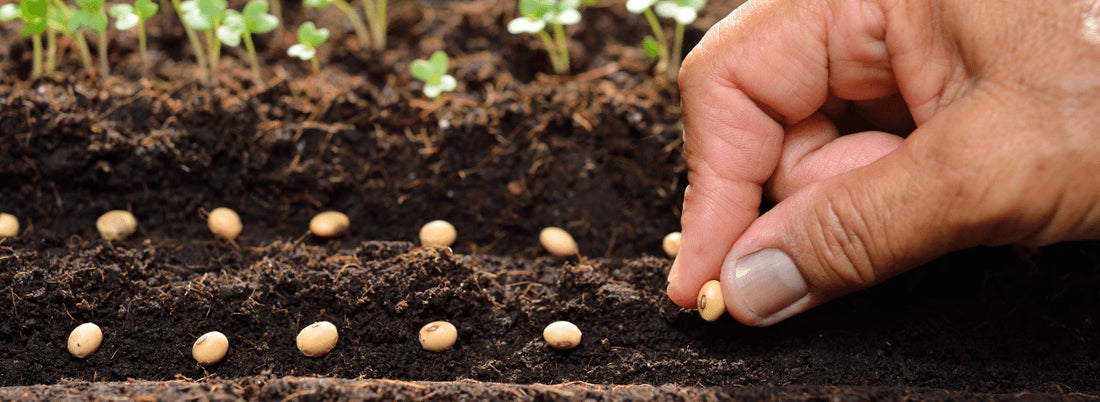
The Essential Guide to Seed Germination for Organic Gardeners
Seed germination is a crucial process in the journey of creating a thriving organic garden. Understanding the fundamentals of this stage empowers gardeners to nurture strong, healthy plants right from the start. By treating your seeds or seedlings with EM-1® you can ensure that your plants get all the essential enzymes and nutrients they need for strong root develop.
1) Quality Seeds:
Selecting high-quality seeds is the initial step towards successful germination. Opt for organic, non-GMO seeds from reputable suppliers. These seeds tend to have a higher germination rate and are free from harmful chemicals.
2) Ideal Conditions:
Creating optimal conditions for germination is essential. Seeds typically require moisture, warmth, and oxygen to sprout. Planting depth, soil temperature, and adequate water supply play pivotal roles. Ensure the planting depth matches the seed's specifications and maintain consistent moisture levels without overwatering.
3) Soil Preparation:
Preparing the soil is key. Use well-draining, nutrient-rich soil to provide the best environment for seeds to germinate. Organic compost or amendments can enhance soil fertility and support healthy seedling growth.
4) Timing and Season:
Understanding the right timing for planting seeds according to the specific needs of each plant is vital. Some seeds thrive when sown directly in the garden soil, while others benefit from indoor germination before being transplanted. Consider the local climate and the recommended planting season for each type of plant.
5) Patience and Observation:
Patience is crucial during germination. Some seeds sprout quickly, while others may take longer. Regularly check the soil moisture, provide adequate light, and observe the emergence of seedlings. Patience and attentive care during this phase set the stage for a successful growing season.
6) Organic Care:
Maintaining an organic approach throughout the germination process and beyond is essential for a healthy garden. Avoid synthetic fertilizers or pesticides that can harm the delicate seedlings. Instead, opt for organic fertilizers, natural pest control methods, and sustainable gardening practices to foster a thriving ecosystem.
7) Transplanting:
Once the seedlings have developed strong roots and several sets of leaves, they can be transplanted into larger containers or the garden. Handle seedlings delicately to avoid damaging the roots, and ensure they have adequate support and protection in their new environment.
“To Plant a Seed is to Believe in Tomorrow”

EM-1® can be used on any seed before planting. Be sure the seeds are not already pre-treated with synthetic antimicrobials or fungicides as this can kill the microorganisms in EM-1® . High-quality, organic seeds are best.
(1) Create a solution of 1 part EM-1® to 1,000 Parts Water or about 1 tsp per gallon.
(2) Submerge seeds and let sit for the following times;
Small Seeds - 20 to 30 Minutes (i.e. mustard, kale, broccoli, cabbage)
Medium Seeds - 30 to 60 Minutes (i.e. cucumber, carrot, peppers, tomato)
Large Seeds - 2 to 3 Hours (i.e. pumpkin, beans, squash)
(3) Air dry seeds before planting if they are sticking
(4) Plant the seeds in nutrient rich soil and water with the same EM-1® solution after planting.
(5) EM-1® can be applied weekly throughout the growing season to increase root and plant growth.
(6) Apply EM® Bokashi as a top dress after seed planting and throughout the growing season bi-weekly.
Use EM-1® to treat your seedlings before planting.
(1) Create a solution of 1 part EM-1® and 1,000 parts water. This equals about 1 tsp per gallon of water.
(2) Soak roots, doing your best to keep plant out of the water, for 12-24 hours.
(3) Plant in nutrient-rich soil and water in with the same 1:1000 solution of EM-1®.
(4) Sprinkle EM® Bokashi as a top dress on the soil.
(5) Continue to apply EM-1® onto the soil or as a foliar weekly and EM® Bokashi on the soil surface bi-weekly.
Have some fun with seed germination!
Seeds can easily be started indoors if the weather is not quite right or you want more control over their growing environment. While some species may not do as well being transplanted, many vegetable varieties do better when started indoors or in the greenhouse. Seed trays work great and are readily available at most plant nurseries, but why not get a little creative and think outside the box instead.
 Germinate seeds in egg shells
Germinate seeds in egg shells
The ultimate in biodegradable material, an empty egg shell provides nutrients to your seed and plant and provides organic matter to the soil. This can decrease the transplant stress since you can simply plant the entire egg and soil into the ground.
 Germinate Peppers seeds in the fruit
Germinate Peppers seeds in the fruit
Have a pepper getting wrinkled and past its ripeness? Cut the pepper in half and knock the seeds into the pepper. Fill with high-quality soil and water in with EM-1®. Keep the pepper indoors if the weather is not warm enough or bury the pepper directly into the ground. The pepper will slowly decompose and provide organic matter and nutrients to the growing seed and seedling.
 Use your empty TP rolls
Use your empty TP rolls
Cardboard provides valuable brown material to compost piles but can also be used to hold seeds. Pack the TP roll with high-quality soil and push the seed down to the recommended depth. These stack nicely together if growing seeds indoors or in the greenhouse, or simply burry the tube in the soil.
 Empty egg cartons are perfect seed trays
Empty egg cartons are perfect seed trays
If your eggs come in cardboard egg cartons, these make for easy recyclable seed trays. Fill the entire carton with high-quality soil. Place 1 seed in each egg spot and cover with more soil. If growing indoors for some time, be sure to use a tray as water will penetrate through. Once you're seedlings are ready to plant, cut out each section and plant with the carton. This provides brown organic material and lessens the transplant stress as roots are undisturbed.
Test EM-1® Yourself
We planted the same organic cucumber seeds in container boxes and gave plants EM-1® weekly and EM® Bokashi bi-weekly. The control received no inputs.

EM-1® Treated cucumbers did significantly better in a simple at-home trial. The strength and vigor of the plant continued to out compete the untreated cucumber.
The untreated cucumber remained healthy and grew well, but was definitely slower then the EM-1® Treated. Plant were planted the same date and were from the same seed package.
